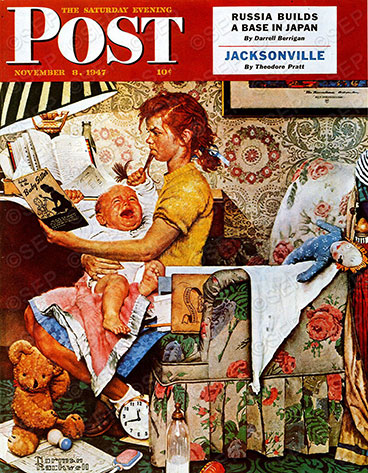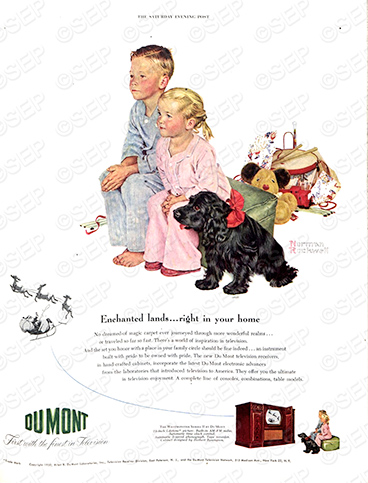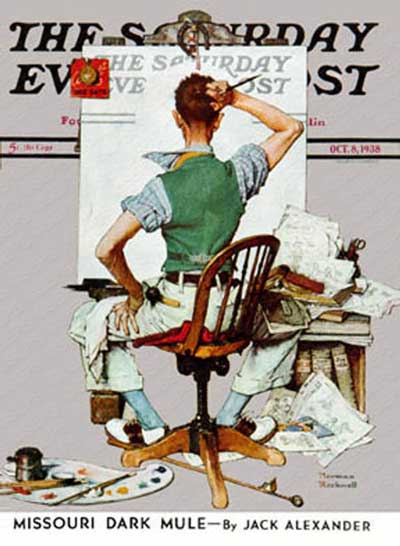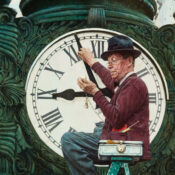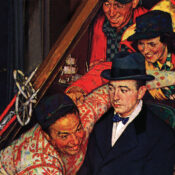Melinda Pelham Murphy, a daughter of Norman Rockwell’s photographer Gene Pelham, grew up around Rockwell’s studio. She talks about being a Rockwell model and the artist’s famous chair and offers a fond remembrance of Rockwell’s wife.
The Babysitter
The Babysitter
Norman Rockwell
November 8, 1947
We would like to say that no babies were harmed in the making of this classic Rockwell cover, but the baby may disagree. During Melinda’s first modeling job, as the crying infant in The Babysitter, the artist and photographer couldn’t get her to cry, so someone stuck her foot with a pin. “My mother told me she always felt terrible about that, but it was what it was.”
“Obviously I was too small to remember anything,” she says. “But somewhere I have a photograph of me that Dad took … and I can see my mother’s image. She’s standing and I’m looking at her, and I am sort of looking sad like, ‘Oh, help me!’” Like many illustrators of the period, Rockwell began by painting live models. But around the mid 1930s, he used photography to capture the scene he would sketch out for a painting, calling the model back if necessary.
The Babysitter shows Rockwell’s ability to capture a dizzying array of details, making it one of those paintings where viewers may pick up something new each time they look at it. And still Melinda brought a fresh detail to our attention: “There’s a pin, an actual pin in the painting. The pin is in the diaper that’s hanging over the chair. He put it right through the canvas, he didn’t paint that in there.” It’s a delightful bit of Rockwell whimsy we were unaware of. Melinda has another viewpoint: “When I found out that I was stuck by a pin and I look at that painting, I wonder if that was the pin that did the deed and then he put it in the picture,” she says, laughing.
Despite the prickly offense, Melinda has a good sense of humor about the situation. In fact, she says she (along with the model baby sitter, Lucille Towne Holton) got involved in keeping the painting where the artist wanted it to be. Rockwell gave the original to the sixth graders of Taft Elementary in Burlington, Vermont, in memory of a student who died of leukemia. The school closed in 1978, and the painting was stored in a local bank. In 1995 appraisers determined it would be worth about $300,000. This was welcome news to the cash-strapped school system, which considered an auction. Former classmates protested and were offered an alternative: raise $300,000 and the painting would remain in town. Many townspeople got involved, and Melinda reports, “We raised the funds and it stays forevermore! It’s at the Fleming Museum; and every time my granddaughter goes there, she says, ‘That’s my grandmother!’ She gets a kick out of it.”
Rockwell Ads
Du Mont TV Ad
Norman Rockwell
December 9, 1950
We first saw Melinda on a recent episode of Antiques Roadshow, where she was having Rockwell artifacts appraised, including a print of this 1950 Du Mont TV ad featuring her at about age 5. The print was accompanied by a note addressed to her father: “…to reimburse your daughter for the long session of posing. Give her my thanks for helping me out. Sincerely, Norman.” We called to ask her about her memories of the artist.
“I do remember him! I remember very well,” Melinda says, although she was only about 5 or 6 when he moved away from her small town in Vermont. “My sister always says to me, ‘I don’t know how you remember all that, I don’t remember these things.’ Maybe I just paid more attention or maybe I just have a different brain. And my sister didn’t pose for him that often.”
What she remembers was a kind man with a fondness for Cokes. This was a treat because soft drinks were limited to “special occasions” at home. But Rockwell had a Coke machine and the models could help themselves on breaks.
Melinda also recalls that Rockwell was particular about the pose he wanted for this ad. “He was very detailed in the way he wanted you to sit,” she says. And sit she did, for 15 hours. The time “would be broken up,” Melinda says, “so he might be working with the boy or the dog, and they didn’t need me” for a while. She remembers the artist’s wife Mary Rockwell who “would take me into the house so I wasn’t just sitting in the studio all that time. She was great about leaping into the breach. I can remember getting a dish of ice cream.”
“It was a long day,” Melinda says, “but Mary took me on a walk. I remember we walked down the back road, and it was a dirt road that ran along the river. And I remember picking ferns with her and then we went back to her garden and got some zinnias.” Melinda’s mother was laid up with an injury at this time, “and I brought her home this bouquet of flowers that Mary had ‘helped’ me put together. She did it all herself, I was very small, but I remember picking the ferns. She was really very sweet. She was a lovely lady. I have very fond memories of being there as a child.”
Blank Canvas
Blank Canvas
Norman Rockwell
October 8, 1938
Painting and drawing appraiser Alasdair Nichol was a bit surprised when Melinda also brought a chair to his table at the Antiques Roadshow, suspecting she had been sent to the wrong area. But when Melinda explained that the chair had belonged to Norman Rockwell and had been depicted in the iconic 1938 cover we see here, he understood. Rockwell’s photographer, Gene Pelham (Melinda’s dad), took the chair after the artist threw it out.
“Dad never threw anything away,” Melinda says. He would salvage discards or “Norman would get these things and say, ‘Here, Gene, take this. I don’t want it.’ Norman was not a hoarder or collector, I don’t think, unless it was something he felt he would need in the long run for paintings—costumes and things.”
But the salvaged chair was special. “To think of the amazing paintings that he did when he was sitting in this chair,” appraiser Nichol said. To see how the cast away chair was evaluated, we have a link to the appraisal, courtesy of the Antiques Roadshow.
Thank you to the Antiques Roadshow for the link to the episode featuring Melinda and to the Norman Rockwell Museum for their assistance in contacting her.
Become a Saturday Evening Post member and enjoy unlimited access. Subscribe now

